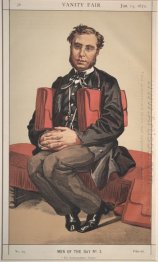James Tissot

James Tissot was a French painter. James Tissot was fascinated with femininity, a trait he meticulously portrayed in genre scenes of fashion and high society that chronicled the late Victorian era.
James Tissot was born James Joseph Jacques Tissot on October 15, 1836 in Nantes, France, the son of successful shopkeepers. Coming from a family of devout Roman Catholics, he spent his early years in a boarding school run by Jesuits. In 1856, he attended the Ecole des Beaux Arts in Paris under Ingres, Flandrin and Lamothe. There he met Whistler, Degas and the impressionists. Whistler’s knowledge of Japanese prints influenced the artist, more specifically the tilted perspectives and flattened spaces that he began to incorporate into his art.
At twenty-three, James Tissot had such a successful exhibition at the Paris Salon that he began to receive commissions to paint portraits of the social elite. The 1860’s proved to be very profitable for the artist; he took residence in the fashionable Bois de Boulogne section of Paris and continued to make his way up the social ladder. Expanding his horizons, he traveled to Italy and then on to London where he exhibited at the Royal Academy in 1864. His paintings portrayed fashionable women in chic gowns, lush garden parties, contemporary life and modern love. Although some people referred to his paintings as "vulgar," his work nevertheless remained in high demand.
During the Franco-Prussian War, the artist fled from Paris to London. James Tissot was regarded as a Commune sympathizer, which meant a prison sentence if he stayed in Paris. London became a sanctuary, and the contacts he had made during previous visits helped establish his career. From 1871 to 1882, the Editor of Vanity Fair assisted in making the transition a little easier by easing Tissot into the right social circles, and providing him a place to reside until he could get onto his feet.
A year later, Tissot bought a house in St John's Wood where he would live out the rest of his life. The expression ‘life imitating art’ could not be more true as he evolved into one of the social elite characters portrayed in his paintings, much to the dismay of other Parisian artists of his day.
James Tissot began to study etching with Sir Seymour Haden, and experimented with printmaking in an effort to reproduce his own paintings rather than sell the rights to other engravers. In 1876, he produced ‘The Thames’ (two women enjoying the company of a gentleman at a picnic). Once regarded as scandalous, this scene has since been judged to be one of his greatest paintings.
He returned to France in 1882 after the passing of his mistress Kathleen Newton, a divorced Irish model, and the great love of his life. She was stricken with tuberculosis and took her own life in 1882. Shunned by society for taking up with a divorced woman (eighteen years his junior) with two illegitimate children, the couple had kept to themselves, rarely attending social gatherings to avoid public scrutiny. He immortalized Kathleen in works such as ‘Quiet’ and ‘Chrysanthemums’.
After the death of his beloved, portrayals of ‘high society’ no longer satisfied the artist. In an effort to find some kind of peace, he began to focus on his own spirituality and expressed it in watercolor drawings of religious scenes inspired by his travels to the Holy Land in the mid 1880’s. His watercolors based on the New Testament were referred to as “a revolution in religious art”. In 1896, his series of 350 drawings depicting incidents in the life of Christ were exhibited in Paris and London.
James Tissot spent his last two years at the abbey in Buillon, France, where he died on August 3, 1902 with his Old Testament project uncompleted.






























































